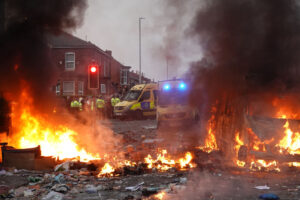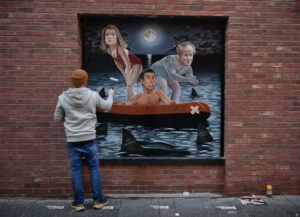“This is my first protest, like,” says an affable man to no one in particular. The anti-immigrant protest assembles on Donegall Place, just where the main shopping street feeds into Belfast’s central square. There’s a line of armoured police land rovers ahead, and a Unity Over Division rally behind them, all Palestinian flags on long poles. Mick Lynch is giving a speech over there. When he starts talking about “the working class”, everyone around me laughs.
The flags are different on this side of the police line. An unlikely mixture of Irish tricolours and Union flags prevails. At the very front, men hold a large banner reading “Coolock Says No”, while others waft a large Israeli flag around. One guy holds a small cross hastily fashioned from cardboard. Masked young men zip about the place, but there are people of all ages here, including young children. Wandering through the throng, I pass two women and a girl of three or four, all identically attired in Barbie pink. “Get ‘em out, get ‘em out,” sings the girl in her soft southern accent, smiling a lovely smile.
An occasional missile is lobbed at the Unity Over Division crowd, mostly water balloons filled with god-knows-what. Twice, the flat reports of fireworks echo off surrounding buildings. “Get ‘em out” is the favoured chant, though as time passes and the crowd swells, the front ranks segue into “Oh Tommy Robinson”. From the other side of the police lines comes “Nazi scum off our streets” and a solitary, rather prim cry of “Degenerates!”
Eventually, the Unity protest disperses. The anti-immigration rally advances, hundreds of people heading across Donegall Square. Two men face off in front of City Hall, footing backwards and forwards on the neat lawn, until one is pulled back by friends. The crowd moves down onto Bradbury Place and walks south. The protest’s goal is the Islamic Centre on University Road. A woman in her 60s asks how far away it is. Ten, maybe fifteen minutes’ walk. “Awk shit,” she says, rolling her eyes.
Police have sealed off the approach to the Islamic Centre with a solid line of land rovers. The crowd rolls on down a parallel road. This is Botanic Avenue, a pleasant street of bookshops, bars, cafes, and restaurants. Word spreads that the Sahara shisha bar has been attacked. Soon afterwards, a group of young men start dragging large restaurant waste bins out into the middle of the road. The makeshift barricade is a decision born of pure instinct, like beavers building a dam. There’s nothing to barricade against just now — there are no police around — and the young men shrug and move on.
The crowd pauses for 10 minutes. Without the Islamic Centre there is no goal. “Is this the way to the mosque?” asks one man plaintively. Then someone moves over to the door of Duke’s Hotel and gives it a kicking. A new plan becomes apparent. Hotels suspected of housing immigrants will do. Shortly afterwards, a young man is using a café table to hammer at the front doors of an Ibis hotel on University Street. The glass doors hold. A veteran in the crowd advises: “Get that hood up.”
The mood changes along with the plan. Numbers are dropping. Many of those who were just along for the ride have melted away. Some guy in a red tracksuit swaggers past. He gestures to my notebook and shouts: “See your book? You shove it up your hole you fucking balloon.” I turn a page and write: “Yng guy red trkst = C ur bk? U shv it up ur hole u fkn bln.” Then I slip it in my pocket.
The crowd moves on. We’re deep in the Holylands now. This locale is full of students during term time, but it’s pretty quiet on a muggy August afternoon. The area isn’t a natural choice for a march — it’s too cramped, too embarrassingly residential. It transpires that the man directing the crowd is from Dublin and has got a bit lost. His unorthodox route seems to have totally blindsided the police, who are nowhere to be seen.
I get chatting to a woman from Portsmouth. “I’ve lived in Belfast 14 years. But I’ve come along today for those three girls, really. The police should be protecting us.” For every hooded youngster there is someone like her, eager to share their sense that society’s machinery has failed at its deepest, most intricate level. Police arrive soon after. Young men stage a happy hardcore dance-off in front of the improvised wall of land rovers. One man gambols over and briefly plants his tricolour on an armoured bonnet before spinning away, delighted. It’s the last Irish flag I’ll see today.
The home stretch doesn’t last long. What remains of the crowd emerges blinking onto the Lower Ormeau Road. This is a broadly Nationalist area, and it doesn’t take long for a counter-protest to form up. Within minutes, men and women have confronted the marchers. The police, still playing catch-up, manage to establish a line between the two groups before the situation degenerates into a street brawl. The locals waste no time in giving the police line a piece of their mind. “How did they get so far up without youse stopping them?” asks one woman, incredulous. “I don’t know how you live with yourselves, protecting these racists,” says a man. At the street corner, an old lady asks for advice on how to get home. She looks so small in her blue anorak. A woman puts her arm around the old lady and they plan a route together.
Soon after that, it’s all over. The few remaining marchers — there can be barely 30 or 40 of them left by now — chant some Loyalist paramilitary acronyms before walking off into the afternoon. A line of riot police sweeps the road behind them. I follow along, wondering what to make of it all. I stop next to a Holiday Inn. Someone’s smashed the window, and a man is already sweeping fragments of glass from the floor.
On the bus home, I look at my phone. Apparently North and South, Nationalist and Unionist, have come together at last. Noted scholar of Irish affairs, Darren Grimes, is among the first to declare a new dawn of cooperation and unity. There are many more like him, convinced that one protest and a handful of TikToks are of great historical moment. Perhaps they’re right. It is certainly true that the crowd I witnessed on Donegall Place was an unusual one. I’ve never seen the Tricolour flown alongside the Union flag in that way. And it was interesting to move among the crowd and hear the accents flip from Northside Dublin to Belfast to Kildare to rural Antrim.
But it is also true that this variety fell away as the day progressed. The march’s final flourish on the Lower Ormeau Road, a mere three and a half hours from the demonstration’s start, saw a swift and instinctive reversion to sectarian business as usual. And the rioting on Sandy Row later that evening, where a man’s supermarket was immolated, was hardly a hands-across-the-border affair. If anything, it echoed the riots of 2021, which took place in exactly the same location, and which were caused in part by the behaviour of Nationalist politicians during Covid.
A local genius for symbolism — its creation, its transmission, and its redeployment to previously unimagined ends — should not be confused for life as it is actually lived. Nor should it be assumed that such symbols belong to one group or sub-group alone; nothing could be further from the truth. I didn’t see a new Ireland on Saturday. I saw two crowds separated by a thin line of police, shouting at one another on an August afternoon.
Disclaimer
Some of the posts we share are controversial and we do not necessarily agree with them in the whole extend. Sometimes we agree with the content or part of it but we do not agree with the narration or language. Nevertheless we find them somehow interesting, valuable and/or informative or we share them, because we strongly believe in freedom of speech, free press and journalism. We strongly encourage you to have a critical approach to all the content, do your own research and analysis to build your own opinion.
We would be glad to have your feedback.
Source: UnHerd Read the original article here: https://unherd.com/



